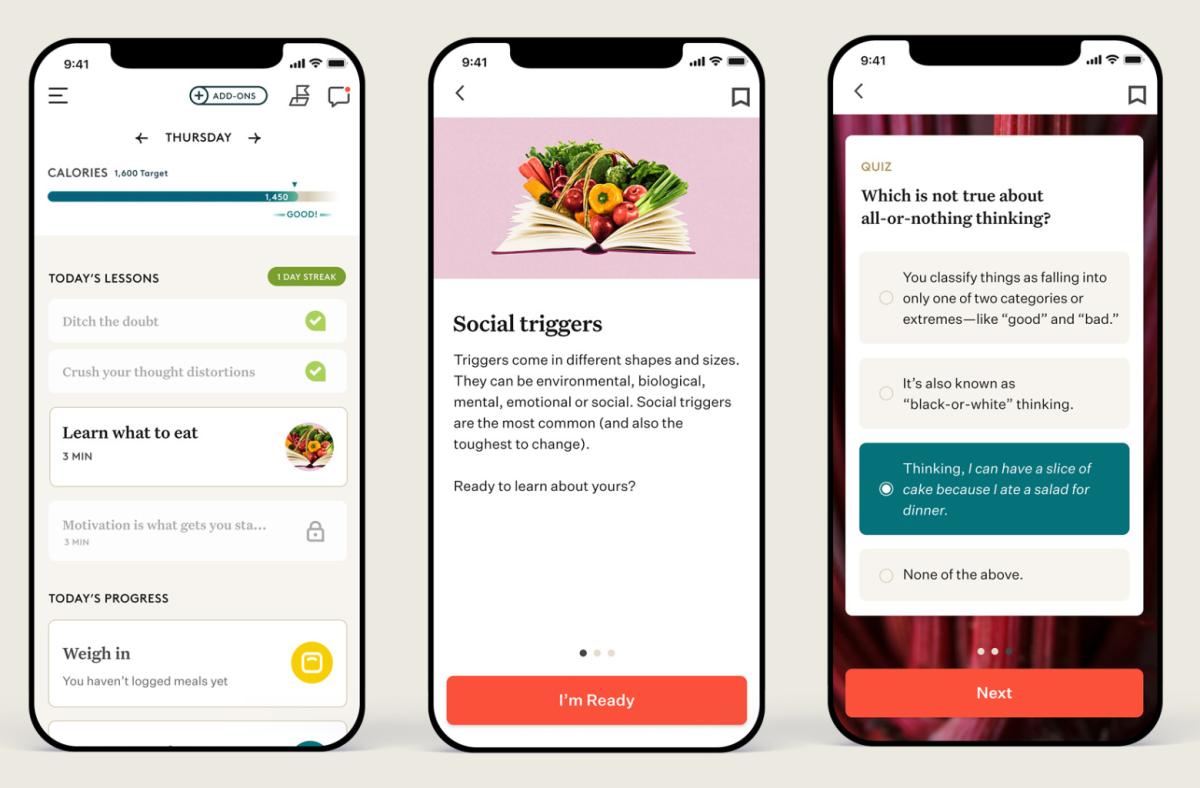As you may know, intermittent fasting is a great way to lose weight pretty quickly. So many people do not get the results they want even when doing IF for short periods of time.
Many people don’t get the results they want because they are not being realistic about their goals and expectations. There’s also a lot of misinformation out there on how to do intermittent fasting as a beginner.
I’ve been an advocate of the benefits of intermittent fasting for quite some time now, as it has helped me lose 45 pounds over 18 months.
I’ve also advocated for Noom’s Weight Loss program to help you lose weight and get in shape without the pain or discomfort of dieting.
Now, can you do intermittent fasting with noom? Noom makes it easy for you to combine these two wellness trends.
What Is Intermittent Fasting?
The idea behind intermittent fasting is simple: you’re just eating within a limited time period. The most popular is the 16/8 method, which says to fast for 16 hours and eat within an 8-hour window.
Many people also add a fasting morning routine (such as not eating for 10-12 hours before their first meal). You get to decide what that looks like based on your lifestyle and schedule.
You might be thinking, “I already do this on my own.” If you regularly skip breakfast or choose not to eat until lunchtime, you’re fasting in one way or another.
Intermittent fasting often gets lumped in with other diet methods under the umbrella of calorie restriction, but it’s much more than that—it’s about health in general and keeping your body functioning at its best.
The most important thing is knowing when you last ate so that you know when it’s time to start again—that way, your body can prepare for the incoming nutrients.
When you fast without knowing when you’ll be eating again, it’s an open invitation for your body to become confused, which can lead to more cravings and feelings of deprivation. It also means that you don’t get to take advantage of the benefits of intermittent fasting, such as improved insulin sensitivity and reduced oxidative stress.
What Is Noom?

While Noom isn’t the first diet app to be developed, it is among the first of its kind. It uses a combination of behavioral psychology and nutrition science to create a personalized weight loss plan for its users.
The app takes into account its users’ BMI, age, gender, weight loss goal, and other factors in order to create a plan that will work best for them. There’s also a personal health coach available via text or email who can answer any questions users may have about their diets.
Noom’s plans are based on the idea that weight loss is best achieved through small changes made over time. This is different from many other diet programs that promise results in just a few weeks or months. Instead, Noom focuses on long-term goals—a healthy lifestyle that can be maintained by each user throughout his or her life.
The program claims to be effective because it addresses all three aspects of weight loss: behavior change, nutrition, and exercise. The app helps users develop new habits for their lifestyles and educates them about what they should (and shouldn’t) be eating.
It also provides workouts that are designed to help users achieve their fitness goals and keep them motivated to stay active while losing weight.
The Noom app also features a personal weight loss coach who provides support and encouragement throughout the process. The app tracks progress, which is essential for users who want to see how effective their strategies are.
Is Noom a Diet?
The question of whether Noom is a diet is an interesting one. The app’s founders call it a “nutrition program,” which is vague enough that eating disorder professionals would probably prefer to label it a diet (since the term “diet” has been used to describe disordered eating patterns as well as healthy eating habits).
However, the support and information that Noom offers users are certainly more in line with a healthy lifestyle than with any unhealthy mindset. In fact, its stoplight system seems like a very positive way to look at the way we eat. Since it’s based on balanced eating (as opposed to counting calories), it’s remarkably similar to what many experts recommend for good health.
Of course, there’s nothing wrong with being on a diet—if you’re trying to lose weight or change your body composition in some way, then that’s exactly what you’re doing.
But this isn’t always the case with people who decide to take on such an approach to nutrition; if Noom were just another fad diet out there, then it would probably be best not to promote it so enthusiastically.
However, since the program takes into account individual needs and goals (it even uses your Fitbit data!), and since its focus is on overall health rather than simply weight loss, it can be a useful tool for those who want to lose weight in a healthy way.
The first thing that jumps out about Noom isn’t actually about the food at all—it’s the color-coded stoplight system for rating your meals.
- A green meal is one where you consume under 15 grams of fat, over 15 grams of carbs, under 300 mg of sodium and over 700 mg of potassium.
- Red is just the opposite – over 15 grams of fat, under 15 grams of carbs, over 300 mg of sodium, and under 700 mg of potassium.
- Yellow is somewhere in between, though it includes a range from 15-300 mg of sodium and 700-1000 mg of potassium.
It seems like there are a lot of restrictions, but since Noom uses these guidelines to calculate your meals’ “healthiness,” it’s really not all that bad.
If you’re eating an orange or red meal every once in a while, it’s going to be balanced out by meals where you are getting plenty of nutrients and staying within your calorie range for the day.
Can You Do Intermittent Fasting with Noom?

Noom Weight has a customizable program that fits with all sorts of intermittent fasting styles, including the 16:8 method, the 5:2 method, alternate-day fasting, and the Warrior Diet.
It automatically adjusts your daily calorie intake based on what you tell it about your lifestyle, so whether you’re fasting during a specific time period or just eating less, Noom Weight will know how to adjust your daily calorie goal accordingly.
There’s good news: Noom can help you overcome the most common intermittent fasting struggles through simple, easy-to-use features and support. With the app, you’ll be able to track your progress and stay motivated every step of the way.
Noom can help you manage cravings, so you don’t give in to them between meals, and even help get your body moving by calculating how many calories you’ve burned after exercise—it’s never been easier to stick to your goals!
Noom’s three-colored food system is designed to help you make healthier food choices during non-fasting periods, which may be more important for your long-term weight loss.
Most intermittent fasting systems advise eating the same thing every day to get into a routine, but no two days are the same in Noom—you might choose salmon and quinoa on Thursday and pancakes on Friday, depending on how you feel and what you want.
And since Noom doesn’t prescribe any specific eating patterns for non-fasting periods, you can stay flexible about what you eat—and prevent yourself from falling into a rut.
Noom also recognizes that some people follow an intermittent fasting system and think that it’s okay to totally abandon healthy foods during their fasting periods. However, Noom doesn’t see this as healthy at all.
You’re better off doing a periodic fast while still maintaining a diet that emphasizes quality nutrition, like their three-colored food system does.
Frequently Asked Questions
Does Noom use intermittent fasting?
Yes. There are a number of different ways you can use Noom Weight to complement your intermittent fasting program. Noom Weight complements many intermittent fasting programs, so you can use the two together to enhance your results.
What is the fastest way to lose weight with Noom?
There are several factors that will help you lose weight: -Tracking all food intake using the Noom app -Drinking green tea and plenty of water -Avoiding processed foods and added sugars -Eating breakfast every day -Exercising regularly. The good news is that you can do all of these things using Noom, which sets you up for success. With the app, there isn’t a single moment when you’re not accountable.
Can you skip meals on Noom?
It’s pretty common to think that once you start following a healthy eating plan, you can’t be expected to eat anything else until the next day—and even then, it should probably be an approved food. But that’s not how Noom works. Instead of being a strict “yes” or “no” about the foods you can eat, and when you can eat them, Noom’s meal plan is designed to offer a wide variety of delicious options that will help keep you from getting bored with your meals and snacks.
What happens on Noom after 16 weeks?
After 16 weeks, Noom will ask you to document your fitness activities and food intake in a “journal” that’s then reviewed by the Noom team. You’ll be able to pick your favorite types of foods and workouts, and Noom will then help you find ways to better incorporate them into your life.
Conclusion
The most important takeaway from this article is that you can develop an intermittent fasting routine that also incorporates the Noom Weight loss program.
As long as you have a healthy diet and don’t go overboard with the fasting, you should be able to fit it into any diet plan.














